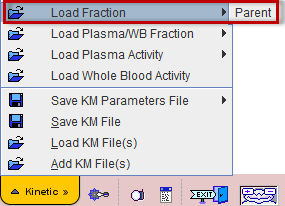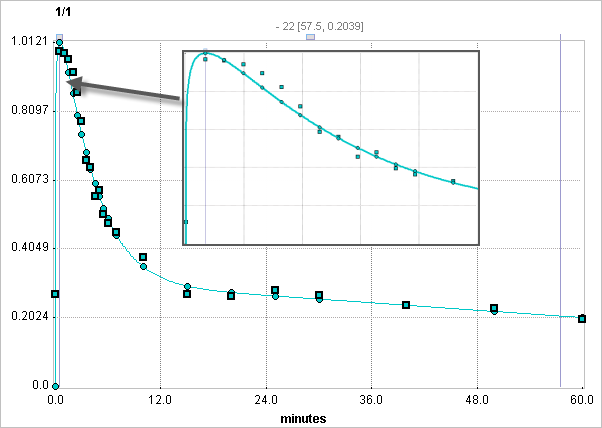The sequential steps for converting blood measurements to an input curve are explained in a dedicated section. The current parent fraction model serves for converting a plasma activity curve into an input curve (authentic, unchanged tracer in plasma).
The Power-Damped Exp model assumes that the concentration ratio of authentic tracer to total tracer in plasma has been determined at certain times during the acquisition and loaded with the Load Fraction entry in the menu.

Operational Model Curve
The general Power-Damped Exp model for the parent fraction handles the situation where the parent fraction starts at a low value and then increases, before dropping. It has the following functional form

The calculated fraction is multiplied with fp, the free fraction of authentic tracer in plasma, i.e. the fraction of tracer not bound to plasma proteins.

Parameter Fitting
The free fraction fp is an input parameter which has no impact on fitting the model curve to the fraction data. The default for fp is 1 as it is experimentally difficult to measure.
The model supports the fitting of the parameters alpha, Amplitude 1, 2, 3 (=A1, A2, A3) and Halftime 1, 2, 3 (=T1, T2, T3). The three Amplitude parameters are restricted to the range [0,1] per default. However, the calculated fractions are not restricted to a certain value range.
Use without Measured Parent Fraction
The Power-Damped Exp parent fraction model can be applied even if no parent fraction measurements were loaded. In this case the user has to specify a parameter set which establishes a representative metabolite correction for the used tracer.
Reference
1.Parsey RV, Ojha A, Ogden RT, Erlandsson K, Kumar D, Landgrebe M, Van Heertum R, Mann JJ: Metabolite considerations in the in vivo quantification of serotonin transporters using 11C-DASB and PET in humans. J Nucl Med 2006, 47(11):1796-1802. PDF